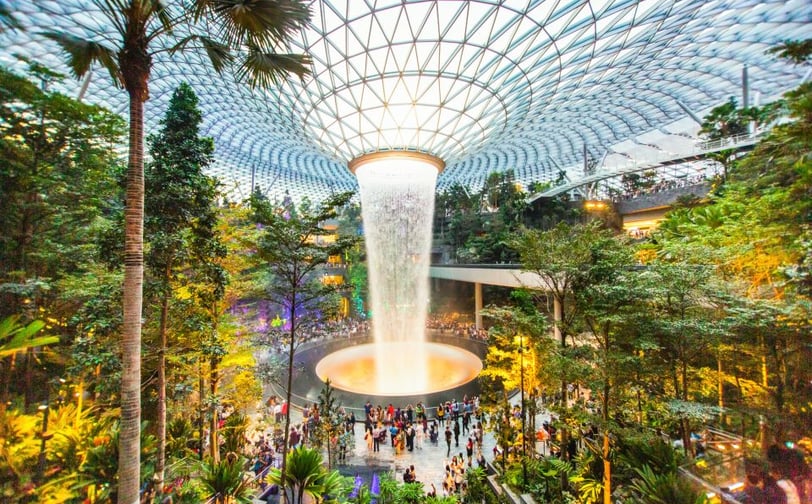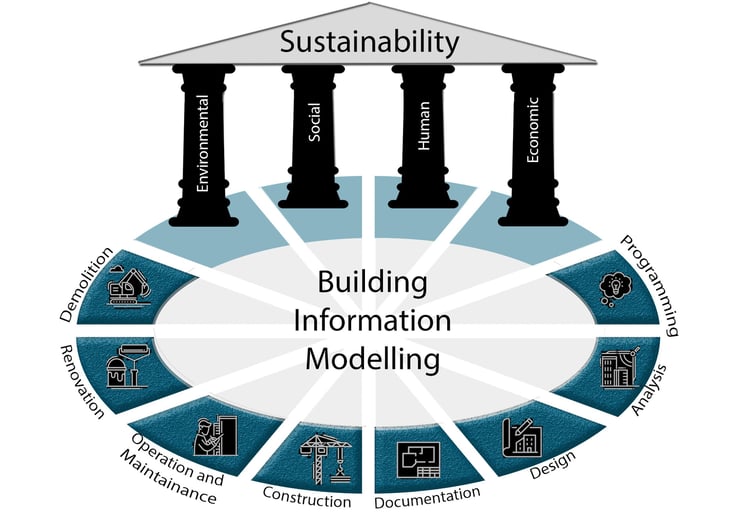Building a sustainable future: Exploring the nexus of Architecture, Sustainability and BIM


The built environment is responsible for approximately half of greenhouse gas emissions, significantly affecting the flora and fauna in its vicinity and globally. Have you ever wondered what can we do more to significantly mitigate these impacts to shape a better and more sustainable future? Let me simplify it for you - Integrating architecture, sustainable design, and Building Information Modeling (BIM) allows us to design buildings that are energy-efficient, resource-conscious, and environmentally friendly. Additionally, leveraging BIM technology helps us assess and minimize the environmental footprint of construction projects. This synergy enhances the efficient use of space, optimizes building materials, and integrates essential information, ensuring minimal ecological impact.
Understanding the Core Concepts
Architecture: This is the art and science of planning, designing, and constructing environments to create functional, usable spaces that cater to the needs of living organisms. It is followed by Architectural Design, where functionality and aesthetics are the two key elements of the process.
Sustainability: At its core, sustainability involves meeting current needs without compromising the ability of future generations to meet theirs. In design, this translates to minimizing non-renewable resources and preserving them for future use. Some of its principles focus on optimizing site potential, protecting and conserving water, increasing energy efficiency, improving indoor air quality, etc.
BIM / VDC or Digital Technologies: These technologies involve planning, designing, and constructing buildings in a virtual environment, before physical construction. This also involves integrating building components with data, making buildings more intelligent and responsive.
Resource Conservation: Reducing energy and water consumption through efficient design and the use of durable materials, sustainable architecture significantly lowers the resource demand of buildings, reducing the environmental footprint.
Pollution Prevention: optimizing design and construction to eliminate waste generation, and reducing emissions, effluents, and other pollutants during operations helps protect environment quality.
Biodiversity Preservation: Protecting existing habitats and restoring the lost ones, sustainable architecture helps in maintaining biodiversity and ecosystem services on an urban scale.
Climate Action: Strategies to mitigate and adapt to climate change, such as reducing the urban heat island effect, greenhouse gas emissions, and use of renewable resources, help in enhancing resilience to climate impacts.
Environmental Benefits:
The Intersection of Architecture and Sustainability
The convergence of architecture, sustainability, and digital technologies, such as BIM, are pivotal in driving the transformation towards a sustainable built environment. This integrated approach not only reduces the ecological footprint, but also enhances the social and economic value of buildings, paving the way for a sustainable future.
Through BIM, we can optimize building design, reduce waste, lower costs, improve collaboration, enable prefabrication and modulator construction, enhance safety, facilitate maintenance and operation, improve building performance, etc. However, it's important to note that BIM is not the silver bullet. BIM is a tool that must be used by experienced and knowledgeable professionals who understand architecture, design, and principles of sustainable design.
In future blogs, we'll explore the 3 pillars of sustainable design as we investigate the current and future landscape of architecture, sustainable built environment, and the use of digital technologies to combat climate change through the power of design and construction.
Achieving Construction Efficiency: Digital models facilitate various construction activities, such as construction planning and scheduling, efficient procurement, coordination with subcontractors and trades, system integration, etc improving overall construction efficiency.
Operation and Maintenance: Once the project is complete the information-rich models act as data repositories, and are tied in with CMMS tools for assisting in managing building operations, including energy and water management and predictive maintenance.
As-Built Modifications: Existing data and designs are used for supporting future renovations, additions, or even demolition.
Post-Design Stage:
Design Development Stage:
Integrated Design: Different elements, processes, systems, and services are integrated into the design at this stage to create efficient designs.
Material Assessment: The creation of models allows for the evaluation of material impact, reduction of waste, and prioritization of renewable materials during the project's planning stages.
Performance analysis: Conduct detailed simulations and analysis for energy efficiency, thermal performance, daylight utilization,
Conflict-Free: Problems are detected early, eliminating them before construction begins, reducing construction waste and project delays.
Enhanced Stakeholder Engagement: Improved communication supports informed decision-making throughout the development stages.
Site Analysis: Optimizing the building form, size, and shape in relation to the site feature helps in the efficient use of naturally available resources, thereby reducing the dependency on artificial systems.
Conceptual modeling: Through creating different design options and iterations, multiple designs can be evaluated to optimize for sustainability and assess the building's climatic impact on the site and the urban environment.
Feasibility Studies: Helps access the viability of different design options considering cost, regulatory framework and environmental constraints.
Preliminary Design Stage:
Sustainability in the built environment focuses on efficient planning, design, material use, and data integration. BIM facilitates a holistic design and analysis approach from early conceptual stages through the design phases to construction and continues till the handover of a project and beyond for additions or even demolition.
BIM : A Catalyst for Sustainable Architecture
Reduced Operating Costs: Effectient and planned architecture, helps lower energy and water bills, which leads to significant savings over the building's lifecycle.
Lower Maintenance Costs: The use of durable materials planned during the design and executed during construction and the lesser requirement on systems and using the efficient ones, reduces long-term maintenance expenses.
Increased Market Value: Sustainable buildings tend to have higher market values due to their sustainable credentials and superior user benefits. It also contributes back to the community hence acts as a central space and an address to have.
Why Sustainable Architecture?
The benefits of sustainable architecture are manifold and can be categorized based on the four pillars environmental, social, human, and economic benefits.
Co-existing with nature: Sustainable architecture supports the nurturing and restoration of biodiversity by bringing green and blue (water) into the buildings, reviving that close bond between humans and nature.
Cultural preservation: Through art and architecture, the culture of a place can be preserved, helping in respecting and integrating cultural diversity and heritage without compromising development.
Community well-being: Integrating green spaces, which include elements of green and blue, results in enhanced health, well-being, and quality of life of the occupants as well as the visitors of a place.
Increased Community Cohesion: Sustainable architecture helps create inviting social spaces, where people can enjoy recreational activities, meet other people, and have common community events.
Economic Benefits:
Social Benefits:
Architecture has not merely been about constructing structures, but largely about how these structures interact with the natural environment. From the time humans moved out of caves, they began shaping their built environment to meet their evolving needs. Until the industrial revolution, buildings were designed in harmony with their surroundings, as seen in planning techniques such as Vaastu and Feng Shui, which remained standard until industrialization disrupted these practices.
In the modern era, the principles of sustainability have resurfaced as essential components of architectural design, driven by the imperative need to combat climate change.


Improved Thermal Comfort: Sustainable architecture requires designing for ventilation, heating, and cooling to create comfortable indoor climates for the occupants.
Better Air Quality: Enhanced natural ventilation and the use of non-toxic materials during construction contribute to healthier indoor environments, and better
Daylight utilization: Maximizing the use of natural light reduces reliance on artificial lighting, therefore improving the well-being of occupants.
Life Longevity: Being close to nature reduces stress, tension, and risk of diseases, thereby increasing the life span of the occupants.
Human Benefits:
BIM facilitates pre-design processes by providing tools for concept generation, schematic design, design analysis, simulations, and generating multiple options and iterations.
Post-Design BIM is used in construction followed by handover to operation and maintenance stages, which carries on throughout the lifecycle of the project
BIM enhances sustainability by improving collaboration during the schematic and design development stages and involves more and more stakeholders during this stages. This leads to


